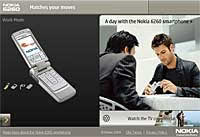 If you’ve ever wished that your answerphone message mumblings could have a bit more pizzazz, Nokia’s new 7710 handset. Xpress audio messaging could become another tool in the podcasters arsenal, enabling podcasting on the move, without a PC. It will all be down to the power of the audio editing software. We’re keen to get our hands on it to see if our hunch is confirmed.
If you’ve ever wished that your answerphone message mumblings could have a bit more pizzazz, Nokia’s new 7710 handset. Xpress audio messaging could become another tool in the podcasters arsenal, enabling podcasting on the move, without a PC. It will all be down to the power of the audio editing software. We’re keen to get our hands on it to see if our hunch is confirmed.
For the straight messaging, Nokia clearly hopes that this will give them some leverage in the highly competitive – and lucrative – youth mobile phone market:
“Nokia Xpress audio messaging enables operators to differentiate their service offering from competitors, by utilizing existing infrastructure,” explains Juha Pinomaa, Vice President, Mobile Phones, Nokia.
“For consumers, Nokia Xpress audio messaging combines ease of use, affordability, and adds a personal touch to greetings, congratulations, or allows to share a special moment like a grandchild’s first words.”
Recorded audio messages can be sent to all MMS-enabled GSM handsets and stored and replayed as easily as any other multimedia file, and Nokia will be introducing support for legacy phones within its MMS solution.
The Nokia Multimedia Application Gateway will also enable sending audio messages to phones that do not support MMS, therefore letting even more people hear your pre-recorded masterpieces.
Nokia is so far, the only MMS infrastructure provider to offer legacy support specifically designed for audio messaging. The new audio messaging menu will be integrated in several Nokia handsets introduced in 2005.
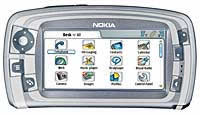 Nokia’s hotly awaited new multimedia smartphone, the
Nokia’s hotly awaited new multimedia smartphone, the  Depending on the sales package, some mobile media applications and services will be pre-installed on the 128 MB MMC, including Mobipocket Reader. This e-book reading application, already popular on Palm/Pocket PC platforms, gives the user access to thousands of titles including current bestsellers.
Depending on the sales package, some mobile media applications and services will be pre-installed on the 128 MB MMC, including Mobipocket Reader. This e-book reading application, already popular on Palm/Pocket PC platforms, gives the user access to thousands of titles including current bestsellers. Video streaming specialists,
Video streaming specialists,  The technology uses Forbidden’s ground breaking FORscene live compressor, that utilises advanced digital compression techniques to deliver a live video feed to PCs, Macs and laptops via the Web.
The technology uses Forbidden’s ground breaking FORscene live compressor, that utilises advanced digital compression techniques to deliver a live video feed to PCs, Macs and laptops via the Web.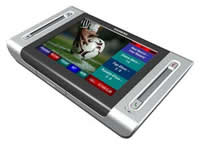 Siemens are planning to make a big splash at the upcoming CeBit in Hannover, Germany.
Siemens are planning to make a big splash at the upcoming CeBit in Hannover, Germany.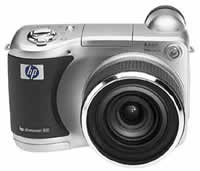 HP is making an interesting move in the digital camera market. The company’s latest technical wizardry is a system in which digital cameras could be equipped with circuits that could be remotely triggered to blur the face of those who don’t want to have their photo taken.
HP is making an interesting move in the digital camera market. The company’s latest technical wizardry is a system in which digital cameras could be equipped with circuits that could be remotely triggered to blur the face of those who don’t want to have their photo taken.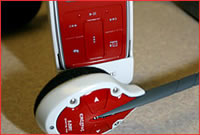 Aura Communications has announced the first samples of its LibertyLink LL888 system-on-chip, for enabling high-quality wireless voice and stereo audio. The chip provides wireless stereo headphone capability for MP3 players, portable DVD players and audio-capable mobile phones – or indeed virtually any portable product where digital audio performance must be coupled with long battery life and low cost. The technology was previewed in ‘real life’ earlier his year by Creative Technology, whose wireless-enabled Zen Micro MP3 player is based on the LibertyLink LL888 chip.
Aura Communications has announced the first samples of its LibertyLink LL888 system-on-chip, for enabling high-quality wireless voice and stereo audio. The chip provides wireless stereo headphone capability for MP3 players, portable DVD players and audio-capable mobile phones – or indeed virtually any portable product where digital audio performance must be coupled with long battery life and low cost. The technology was previewed in ‘real life’ earlier his year by Creative Technology, whose wireless-enabled Zen Micro MP3 player is based on the LibertyLink LL888 chip. Few topics are as hot as mobile music right now, with the Midem Mobile Music Forum the place to be on the subject. Panelists touched upon several important areas, with all attempting to understand the future direction of explosive medium. Once again,
Few topics are as hot as mobile music right now, with the Midem Mobile Music Forum the place to be on the subject. Panelists touched upon several important areas, with all attempting to understand the future direction of explosive medium. Once again, 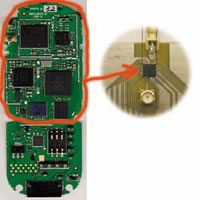 Texas Instruments (TI) has announced they will bring a integrated single-chip solution for mobile phones.
Texas Instruments (TI) has announced they will bring a integrated single-chip solution for mobile phones.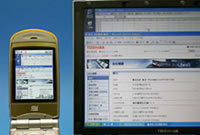 Toshiba has announced software to remotely execute programs on a PC, via a mobile phone. They call it Ubiquitous Viewer.
Toshiba has announced software to remotely execute programs on a PC, via a mobile phone. They call it Ubiquitous Viewer. News International, the publisher of well known UK tabloid ‘newspaper’, The Sun, has opened the doors on its own mobile content service that it calls Sun Mobile.
News International, the publisher of well known UK tabloid ‘newspaper’, The Sun, has opened the doors on its own mobile content service that it calls Sun Mobile.